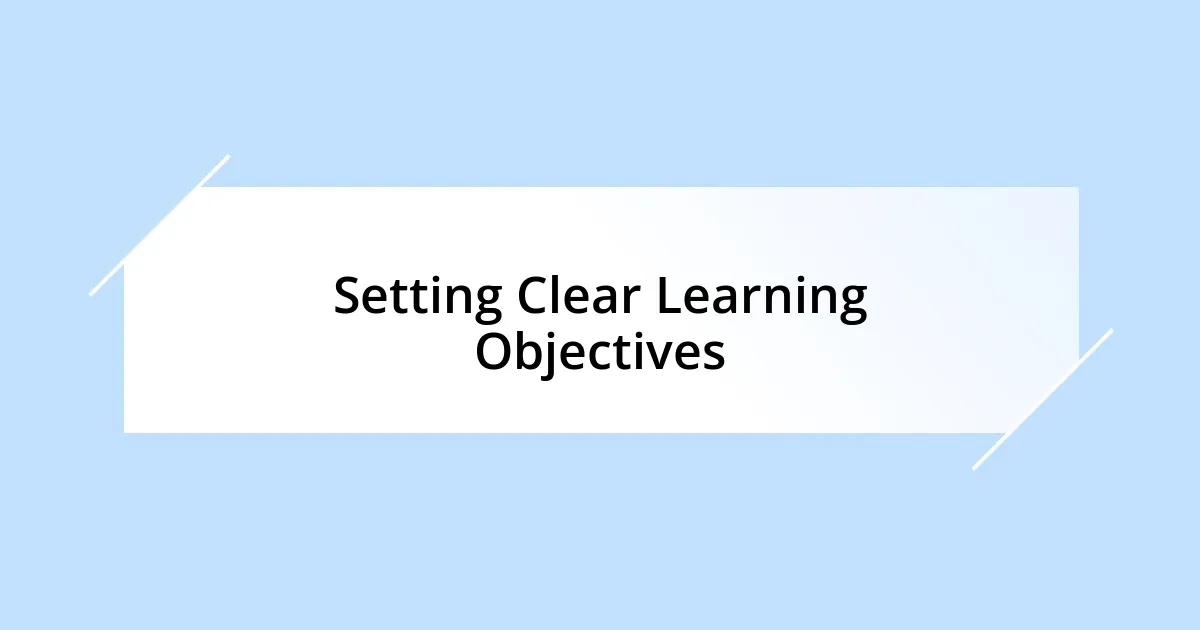Key takeaways:
- Effective class time management involves prioritizing tasks and allocating focused time for activities like brainstorming to reduce stress before deadlines.
- Setting clear learning objectives enhances focus, engagement, and retention, making learning more purposeful.
- Creating a structured class agenda allows for better organization, reducing anxiety and increasing engagement through defined time slots and participation points.
- Incorporating feedback from students empowers continuous improvement in teaching strategies, fostering a collaborative learning environment.

Understanding Class Time Management
Understanding how to manage class time effectively is more than just scheduling; it involves prioritizing tasks and being aware of how time affects learning dynamics. I remember those frantic moments before a project deadline—cramming everything in felt overwhelming, yet looking back, I realized that allocating even short increments for brainstorming or outlining could have eased that pressure significantly.
When I think about class time management, I often ask myself: “Am I truly using this time to its fullest potential?” There’s a difference between being busy and being productive. For instance, I started dedicating my first ten minutes of class to jot down key points or questions, which really shifted my focus and made the rest of the session more intentional. Those small changes transformed my learning experience entirely.
It’s also essential to recognize that each class has its unique flow—I learned this the hard way during a particularly engaging history class. I was so eager to participate that I ended up losing track of the scheduled topics. Balancing enthusiasm with time awareness became a valuable lesson for me. How do you juggle that excitement while staying on track? Reflecting on this balance helps ensure that your learning stays vibrant yet structured.

Setting Clear Learning Objectives
Setting clear learning objectives is crucial for effective class time management. I’ve found that having a well-defined goal not only sharpens my focus but also provides a roadmap for what I hope to achieve in each session. For instance, when I started my semester with a list of clear objectives, it felt like I was stepping into the classroom with a purpose rather than just going through the motions. This simple shift made my engagement levels soar.
I remember a time when I didn’t set specific learning goals. I attended a workshop that was packed with information, but without clear objectives, I felt overwhelmed and retained very little. It was an eye-opener! Now, I encourage myself and my peers to ask, “What do I want to learn by the end of this class?” This single question transforms the learning experience and ignites curiosity, allowing me to dive deeper into the subject matter instead of skimming the surface.
Moreover, writing down these objectives at the beginning of each class has become a ritual for me. It’s akin to lighting a candle before a meal; it sets the tone for the learning experience. I often glance back at those objectives throughout the session, which keeps me anchored. When students see where they’re headed, they become more active participants. Isn’t it fascinating how a few simple words can chart a path through complex content?
| Aspect | With Clear Objectives |
|---|---|
| Focus | Sharpened, directed toward specific outcomes |
| Engagement | Higher, as students know what to aim for |
| Retention | Improved, due to towards purposeful learning |

Creating a Structured Class Agenda
Creating a structured class agenda has been transformative for how I manage my time and focus in class. I distinctly remember my early days in college, where I would often flop between topics without much direction. Crafting a structured agenda, however, allowed me to compartmentalize the material and allocate specific time slots for each topic, which eased my anxiety and heightened my engagement. Now, I relish the clarity that an agenda brings—it’s like having a guide through a complex landscape.
Here’s what I typically include in my structured agenda:
- Topic Overview: A brief description of each subject to be covered.
- Time Allocation: Specific time blocks for each section to keep me on track.
- Active Participation Points: Opportunities for me to contribute or ask questions, ensuring I remain engaged.
- Breaks: Short breaks to rejuvenate and reflect on the content without feeling rushed.
I also recommend revisiting this agenda throughout the session. I often find myself reflecting on how much I’ve covered, which enables me to adjust if needed. Structuring my agenda this way turned my classroom experience from chaotic to engaging, transforming how I absorb information.

Implementing Time-Saving Techniques
Implementing time-saving techniques has made a notable difference in my class management. One method I swear by is the Pomodoro Technique, where I work in focused bursts of 25 minutes followed by a 5-minute break. Initially, I was skeptical about short breaks disrupting my flow, but I soon discovered that stepping away momentarily rejuvenated my mind. Have you ever felt that post-break clarity? It’s quite exhilarating, and it keeps my concentration sharp throughout the session.
To further streamline my workload, I often utilize digital tools for organization. Apps that allow me to create to-do lists or set reminders mean I’m not lost in a sea of tasks. I vividly recall a particularly overwhelming week filled with assignments; it hit me like a ton of bricks! By adopting these tools, I felt like I’d unearthed a treasure map, directing me toward completion instead of floundering in confusion. I often ask myself: why complicate things when technology can simplify them?
Another technique I’ve embraced is batching similar tasks. For instance, I dedicate time slots for reading, writing, and studying instead of jumping between activities. This way, I’m essentially training my brain to stay in the same mode, which enhances my efficiency. I remember a time when I would flit from lectures to notes and back to reading, feeling mentally drained. Once I committed to batching my tasks, that fatigue diminished significantly. Isn’t it liberating to experience flow instead of chaos?

Encouraging Student Participation
Encouraging student participation is something I’ve come to value deeply in my classes. I remember a particularly dynamic session where I prompted students to share their thoughts using a simple yet effective tool—Turn and Talk. Students paired up for two minutes to discuss a question I posed, and the energy in the room shifted instantly. It’s amazing how a little structure can spark a flood of ideas, don’t you think?
Sometimes, I’ll even share my own experiences related to a topic to invite more open dialogue. I recall discussing a challenging project I encountered in college. As I opened up about my struggles, the students began to share their own experiences, sparking a discussion brimming with vulnerability and insight. Watching them relate to one another was a profound moment; it reinforced my belief in the power of shared experiences. Have you ever experienced that kind of connection in a class? It’s truly one of the most rewarding aspects of teaching.
Additionally, I’ve learned that using interactive techniques like polls or quick quizzes can also create a buzz in the classroom. I once introduced a fun quiz related to our subject matter, and the students’ excitement reminded me why I adore teaching. The laughter and friendly competition broke down barriers, making it much easier for timid voices to join in. I often find myself asking: how can we make learning less daunting and more like a conversation among friends? Establishing an environment where everyone feels comfortable to participate is essential, and I relish every moment of that journey.

Assessing Time Management Success
Assessing my time management success often comes down to reflection and evaluation. I take a moment at the end of each week to review what I accomplished and what didn’t quite go as planned. Honestly, it can feel a bit vulnerable to confront those unmet goals, but this honesty allows me to adjust my strategies moving forward. Has it ever struck you how insightful it is to track your progress over time?
An essential part of this assessment process is understanding the impact of my time management on my stress levels. I recall one particularly hectic month where I juggled numerous deadlines; it felt like a never-ending whirlwind. When I took the time to review my calendar and see if I truly managed my time well, it opened my eyes to areas of improvement. Realizing what led to that chaos motivated me to address my scheduling habits. When was the last time you reflected on how a simple adjustment could transform your workload?
Moreover, I ensure to celebrate the small victories, too. Each time I stick to a plan or finish an assignment ahead of time, I allow myself a moment to appreciate that success. I remember the sense of relief washing over me after a long week when I hit all my targets; it felt like crossing a finish line. How rewarding is it to recognize those milestones, no matter how small, in our time management journey? They serve as reminders that each step forward counts, ultimately enhancing my efficiency and focus.

Adjusting Strategies for Improvement
Adjusting my strategies for improvement often requires a willingness to experiment and adapt. I once tried incorporating time blocks into my teaching schedule, and I’ll admit—at first, I struggled to stick to them. But as I fine-tuned my approach, I found that allowing for flexibility within those blocks made a significant difference. Have you ever discovered that a little flexibility can lead to greater creativity in your plans?
I vividly remember a time when a planned discussion ran longer than I anticipated, which initially stressed me out. Instead of pushing to cover all the planned material, I made the choice to embrace the moment and let the conversation flow. That decision bonded the class, and the insights shared proved far richer than any textbook could offer. Isn’t it fascinating how sometimes, stepping back can lead to deeper learning?














